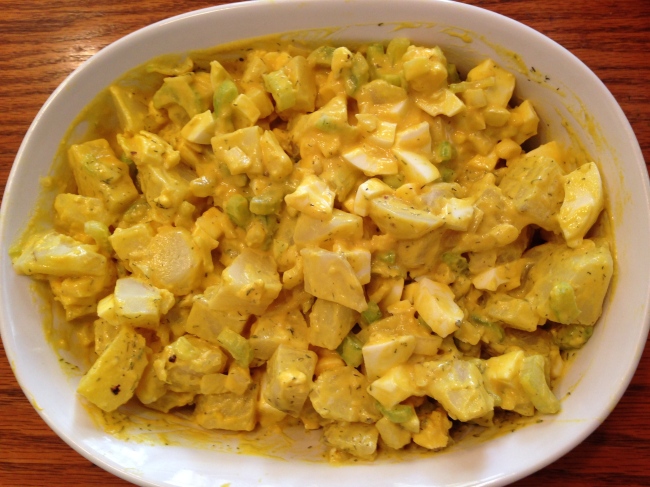My nephew’s birthday was this week, and his mom served potato salad. Oh, how I love potato salad! I haven’t had it in ages because, honestly, I kind of forgot about it–it’s not in my regular rotation, so it’s not really top of mind.
But there’s no reason it shouldn’t be. Potato salad is not the most nutrient-dense food in the entire universe, but it’s not bad for you either (when you make it yourself using peeled potatoes and paleo mayo). Side note: while skinless potatoes are paleo, they’re still probably not appropriate to eat regularly if your goal is weight loss.
Step 1: Make the Mayo.
Lean In. It’s honestly not that hard. And your homemade version won’t have any of the preservatives or additives that grocery store mayos do.
I used this receipe from Alton Brown, one of my favorite celebrity chefs. There’s even a video at the link if you’re really nervous, but I promise it is so easy a caveman could do it (see what I did there?). Important note: be sure to sub a paleo-safe oil–corn and safflower oil are both verboten. I used olive oil and thought it turned out nice–the olive oil is an assertive flavor, but I like it, so I was fine with it. (If you want a less assertive olive flavor, don’t use extra-virgin, or sub something fancy like avocado oil.)
Step Two: Everything Else
Ingredients:
- About 2 lbs russet potatoes, peeled and cubed
- 5 hard boiled eggs, chopped
- 4 stalks celery, sliced thinly
- 1 small onion
- 1/2 c. paleo mayonnaise (see the Alton Brown recipe above, made with olive oil)
- 1/2 c. yellow mustard
- Salt, pepper, dill to taste
Method:
Rinse your peeled and cubed potatoes well and put them in a saucepan filled with cold water. Heat until the potatoes are still firm and just barely cooked through. (I actually poured off the hot water and refilled with cold a few times during cooking. It takes longer to cook the potatoes this way, but I like the texture better. Plus, the cooling and reheating helps create resistant starch.) Dump out the hot water and shock with cold water to stop the cooking process and get some resistant starch going (see below).
While your potatoes are cooking, dice your onion and let it sit in a cup of cold water until everything else is done. (This gets rid of that bitter dragon onion breath effect that raw onions can have. Thanks to the show Chopped for that tip.)
Dump everything together in a casserole dish and stir.
Bonus Side Benefit: Healthy Gut Flora!
Resistant starch is the other kind of fiber, the (until lately) unsung hero that helps keep our gut bacteria happy.
The key to getting the most resistant starch out of your potatoes is to cook and cool them, ideally multiple times (the law of diminishing returns does apply). Resistant starch is created in the retrogradation process. Basically, when you cook potatoes, the amylose and amylopectin break down into component parts. When you cool the potatoes, the components realign and reform in a more crystallized structure that is more resistant to digestion. Since it is resistant to digestion, the resistant starch makes it out of the stomach and into the large intestine, where it is converted to butyrate.
Butyrate is food for good gut bacteria, which help keep everything in your body working smoothly. Research has shown that butyrate could even be a potential treatment for metabolic syndrome, since it increases insulin sensitivity and reduces hunger–even through to your next meal. (Among other health benefits. Yet another reason why you shouldn’t feel guilty about eating butter, which gave the name to butyrate!)


